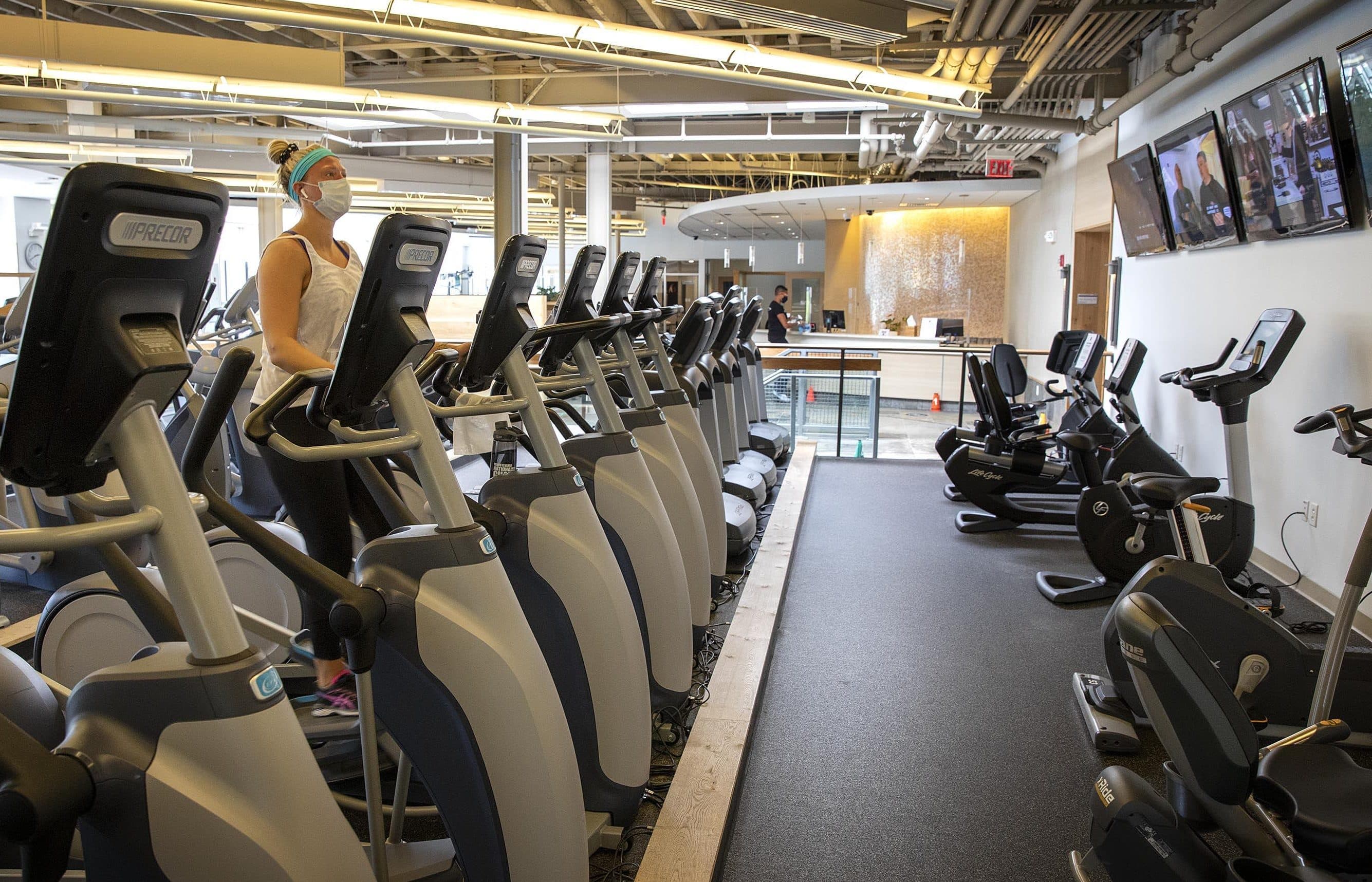Advertisement
The Gym, At Home Or Outside: What Are The Risks For Your Winter Workout?

In these pandemic times, our regular routines have been disrupted – and that is especially true when it comes to getting our bodies moving. Exercise is extremely important to our personal health: it can help reduce chronic diseases and conditions that could make recovering from COVID-19 more difficult, and there's evidence that suggests regular exercise helps to keep our immune systems strong.
During the summer, warm temperatures made it easy to exercise outdoors, at home or at outdoor gym classes. But now that cooler temperatures have arrived, that's become trickier. So what's the best way to workout now? Workout at home? Brave the cold? Workout at an indoor gym? And most importantly: What do you need to do to keep yourself safe?
We know it's a daunting decision to make during a time when it's already difficult to stay motivated to move. But don't sweat it. We spoke to two local doctors – Cassandra Pierre, an infectious disease physician and assistant professor of medicine at the Boston University School of Medicine, and I-Min Lee, an epidemiologist at Brigham and Women’s Hospital and a professor of epidemiology at the Harvard T.H. Chan School of Public Health – to go over the risks associated with each winter workout option.
At Home Workouts (Outdoors Or Indoors)
Both Pierre and Lee agree that outdoor workouts are your best option in terms of safety. That's probably not the answer you want to hear since New England winters can be harsh, but Pierre thinks we collectively need a change in mindset — and some warm clothes.
"Get hand warmers, get appropriate winter coats and winter shoes that will allow yourself to walk, to run, to do what you need to do in the winter months to keep yourself safe and also healthy," Pierre said. "This is a marathon. And we don't want to have a breakdown in mental health because of our inability to go outside or our unwillingness to go outside."
Walking is another easy way for people to get moving without being indoors. It requires no special equipment — just your usual winter coat, shoes and face mask! And Lee says it's something many would be doing anyway to get to and from public transportation, so you can replace those steps with a daily walk.
When conditions force you to head inside, there's still plenty you can do to move — even if space or equipment is limited where you live. Lee suggests using household items like cans of food or jugs of water as weight replacements.
The American Heart Association has a collection of virtual workouts and streaming events to help you get moving at home without equipment. It also offers virtual well-being and yoga videos to help reduce stress.
Outside Workouts, With A Gym Or Small Group
Same rules as above apply. Wear appropriate clothing — and that includes a mask. For outdoor classes, Pierre says make sure there are no more than 20 people in a class and that any and all equipment is appropriately spaced. Be sure to maintain six feet of distance or further, if you can (twice that distance is even better, she added).
Both Pierre and Lee acknowledge that many people can't afford to attend an outdoor gym class. (Or some just don't want to, and that's perfectly OK, too.) Luckily, there are plenty of other ways to get moving in the winter with friends like sledding, ice skating and snowball fights.
"All of those things can bring back some merriment, joy and childlike happiness given this dark time," Pierre said. "So those are the other things that we could potentially safely engage in with friend groups."
Just be sure to bundle up, and keep your mask on.
Inside A Gym
Anytime you move indoors, things get riskier, according to both Pierre and Lee. People should be masked at all times, health experts emphasize, and equipment should be properly spaced. If you don't like what you see upon entering a gym, don't hesitate to leave.
"I would say check out the gym," Lee said. "Do they regularly clean and sanitize it? Are there times throughout the day that people can't come in so they can do a deep cleaning? Do they have special ventilation systems and purifiers put in? Are the staff wearing masks? Is the equipment well spaced?"
Another thing to consider: Some gyms, like local YMCAs, are letting members sign up for time slots to avoid crowding, according to Pierre. She said it might be a good option for those who want to pick time slots that typically attract less people.
When you're done working out, be sure to wipe down the equipment. Even though the risk of COVID-19 transmission from surfaces is low, our experts said it's still important.
"Is the risk of transmission [from surfaces] zero? No," Lee said, "so this is something you can easily do to minimize the risk, and it's not asking you to do a lot."
Inside, At A Group Class
First things first: Class sizes should be small (under 10 people per Gov. Charlie Baker's guidance), and the same rules as above apply: Wear a mask at all times, and make sure people and equipment have plenty of space.
Appropriate distance – 6 feet at minimum – does vary depending on the kind of exercise you pick. In classes where you're breathing more heavily, you may need more space between attendees. But Lee realizes people are not likely to change their workout preferences during the pandemic: "CrossFitters aren't about to become yoga enthusiasts."
"What you pick has more to do with the environment around the kinds of exercise you would pick," she continued. "You have to think about the crowding, the ventilation, the surfaces, in addition to the intensity of exercise."
One way to be in more control: bring your own mat, kettlebells or other equipment to class, when possible, to reduce shared surfaces.
Does Sweat Change The Effectiveness Of My Mask?
Yes, it does.
"Perspiring and just the increasing secretions that we have from our respiratory tract during intensive exercise can moisten the mask, contaminate it, which reduces its effectiveness as a barrier," Pierre said. "So you have less filtration and more ability for secretions from the outside to permeate through that mask. It also potentially weakens the barriers, the seal of the mask around the edges of your face as well. So you might also have increased susceptibility to respiratory particles entering your mask from those those gaps."
What should you do?
Pierre recommends bringing an extra mask or two, if you can. You may need to change into a fresh one during – or right after – your workout, depending on how much you sweat.
Another thing about masks: There are a lot of performance-style masks out there for exercise. But the most effective mask, according to Pierre, is the one you can wear comfortably for the longest period of time.
Winter Sports
Cold weather offers plenty of options that aren't available in the summer months. Think snowshoeing, cross-country skiing and ice skating. If you own your own equipment, that's better. Avoid contact sports like ice hockey, Lee said, and stick to other activities that are easier to do on your own and at a distance from others, like skiing and snowboarding. And as we've said above, outdoors is always the safest option.
Other Important Reminders & Resources:
- The MayoClinic offers tips on how to safely exercise outdoors in winter weather.
- Tony Maloney, exercise physiologist and fitness center manager at the National Institute For Fitness And Sport, gave Here & Now suggestions for getting exercise at home, including playing with people in your household.
- Runners: Here are some tips to help runners keep themselves and others safe during the pandemic.
- Listen to this episode from WBUR's podcast, "Food, We Need To Talk," if you need motivation. When eating experts were asked to give one recommendation for lifelong health, none of them focused on food. All had the same answer: just exercise.
